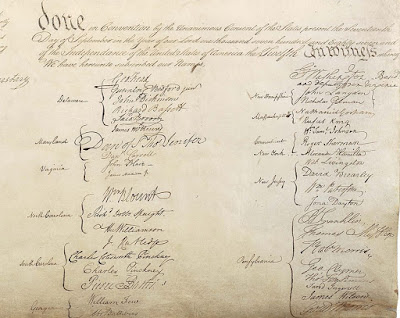 |
|
The Federalist: A Collection of Essays, written in Favour of the New
Constitution
Courtesy baumanrarebooks.com
|
“Who Tells Your Story?” is a central theme in Lin-Manuel Miranda’s Broadway blockbuster Hamilton: An American Musical, currently touring in California. It also thematically links CHS’s current exhibitions Alexander Hamilton: Treasures from the New-York Historical Society and Meanwhile Out West: Colonizing California, 1769–1821—two colonial stories, eastern and western, that provide perspectives beyond unbiased and objective historical records.
Two hundred thirty years ago today, on October 27, 1787, a story with considerable impact on our new nation began, not in the halls of entertainment but in the theatre of political writing and discourse. It was a passionate story of support for the newly conceived United States Constitution—a document proposing a unique though unexpected way to govern our newborn union.
The story opens with the publication of the first of eighty-five articles in The Federalist (later The Federalist Papers), which promoted the ratification of the Constitution. Authored by Founding Fathers Alexander Hamilton, John Jay, and James Madison under the pseudonym Publius (Latin for “public”), The Federalist was written over ten months, between October 1787 and May 1788, to influence the ratification debate primarily in New York.
 |
|
Title page, Publius, The
Federalist, vol. 1, 1788
Rare Books and Special Collections Division, Library of Congress
|
Alexander Hamilton (c.
1755–1804) wrote a majority of the articles, including the General Introduction, in
which he urged his fellow New Yorkers and countrymen to adopt the Constitution: “I am convinced that this is the safest
course for your liberty, your dignity, and your happiness.” Ratification,
he wrote, “speaks its own importance; comprehending in its consequences nothing
less than the existence of the UNION, the safety and welfare of the parts of
which it is composed, the fate of an empire in many respects the most
interesting in the world.” He further explained:
“For nothing can be
more evident, to those who are able to take an enlarged view of the subject than
the alternative of an adoption of the new Constitution or a dismemberment of
the Union.”
 |
|
John Trumbull (American artist), Alexander Hamilton, after 1804
New-York
Historical Society, Gift of Thomas Jefferson Bryan, 1867.305 |
The Constitution's sole signatory from New York, Hamilton had returned to the state from the Constitutional Convention in Philadelphia facing strong opposition from Governor George Clinton, his widespread anti-Constitution followers, and his threatening political machine. Undeterred, Hamilton engaged Madison and Jay in the herculean effort ahead of him.
Despite
The Federalist’s high-brow approach, Hamilton,
Madison, and Jay achieved their goal three weeks after their last paper was
published, when on July 26, 1788, in the Poughkeepsie Court House, the State of
New York ratified the Constitution and became the eleventh state of the Union.
 |
Signatures of the United States Constitution, detail of page 4
Courtesy National Archives and Records Administration
|
Even
before New York’s ratification, Hamilton was honored during the city’s July 23,
1788, Federal Procession, a celebration following the Constitution’s ratification
by New Hampshire. His image, as reported in a history of the city, “was carried
aloft on banners in every part of the procession, the Constitution in his right
hand and the Confederation in his left. He had to all appearances turned the
scale for the Union, and fame was indeed crowning him with well-earned and
enduring laurels.” The procession’s centerpiece, the Federal ship Hamilton, fired 13-gun salutes, one for
each state, from its position on a platform drawn by ten horses. The ship anchored
at the Bowling Green, “amidst the acclamations of thousands,” remaining on view
until June 30, 1789.
 |
|
Unknown artist,
The Federal Ship Hamilton, c. 1877
Courtesy https://www.nyhistory.org
|
As biographer Ron Chernow has written, “Americans often wonder how this moment could have spawned such extraordinary men as Hamilton and Madison. Part of the answer is that the Revolution produced an insatiable need for thinkers who could generate ideas and wordsmiths who could lucidly expound them.” Indeed, Hamilton served as General George Washington’s aide during the Revolutionary War, the nation’s first Secretary of the Treasury under President Washington, and New York State assemblyman; he was founder of the Bank of New York, a designer of the two-party system, and a proponent of ending the legality of the international slave trade.
The
impact of The Federalist was
immediate. Not only did it influence ratification, the publication’s title
became the name of the pro-Constitution movement and, later, Hamilton’s
political party (1789–1824). To this day, The
Federalist Papers is considered a masterpiece of political thought,
renowned, Chernow points out, “as the foremost exposition of the Constitution.”
In
today’s volatile political climate, when we weigh what seems like multiple
interpretations of our nation’s rules of law, we might think of the story of The Federalist as one of indefatigable patriotism.
But politics aside, we are, Chernow reminds us, “indisputably the heirs to
Hamilton’s America, and to repudiate his legacy is, in many ways, to repudiate
the modern world.”
 |
| Two Bay Area students look at the Federalist papers in the current California Historical Society exhibition, Alexander Hamilton: Treasures from the New-York Historical Society |
Shelly Kale
Publications
and Strategic Projects Manager
Sources
Ron Chernow, Alexander Hamilton (New York: Penguin
Books, 2004)
Martha J. Lamb, History of the City of New
York: Its Origin, Rise and Progress, vol. II (New York: A.S. Barnes & Co.,
1877; reprint 1921 by Valentine’s Manual, Inc.); books.google.com
Nation at the Crossroads: The Great New
York Debate over the Constitution, 1787–88; https://www.nyhistory.org/web/crossroads/gallery/celebrations/federal_ship_hamilton.html
The Project Gutenberg EBook of The Federalist Papers, by Alexander
Hamilton and John Jay and James Madison; http://www.gutenberg.org/cache/epub/18/pg18-images.html
















